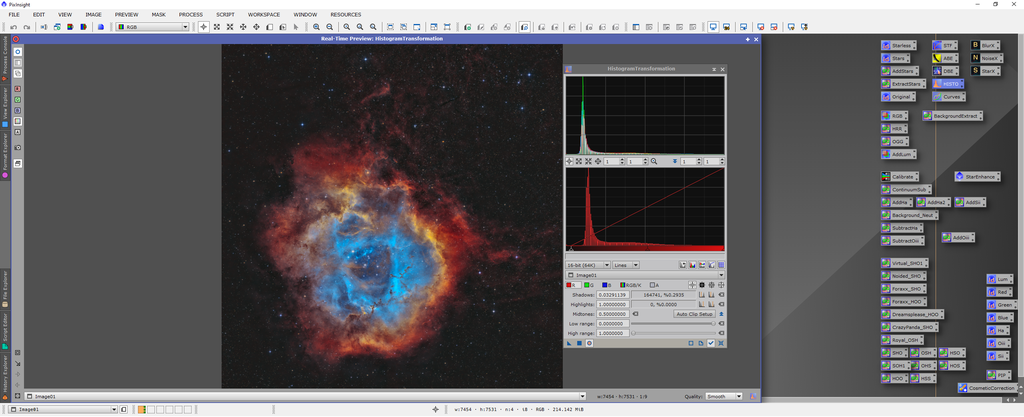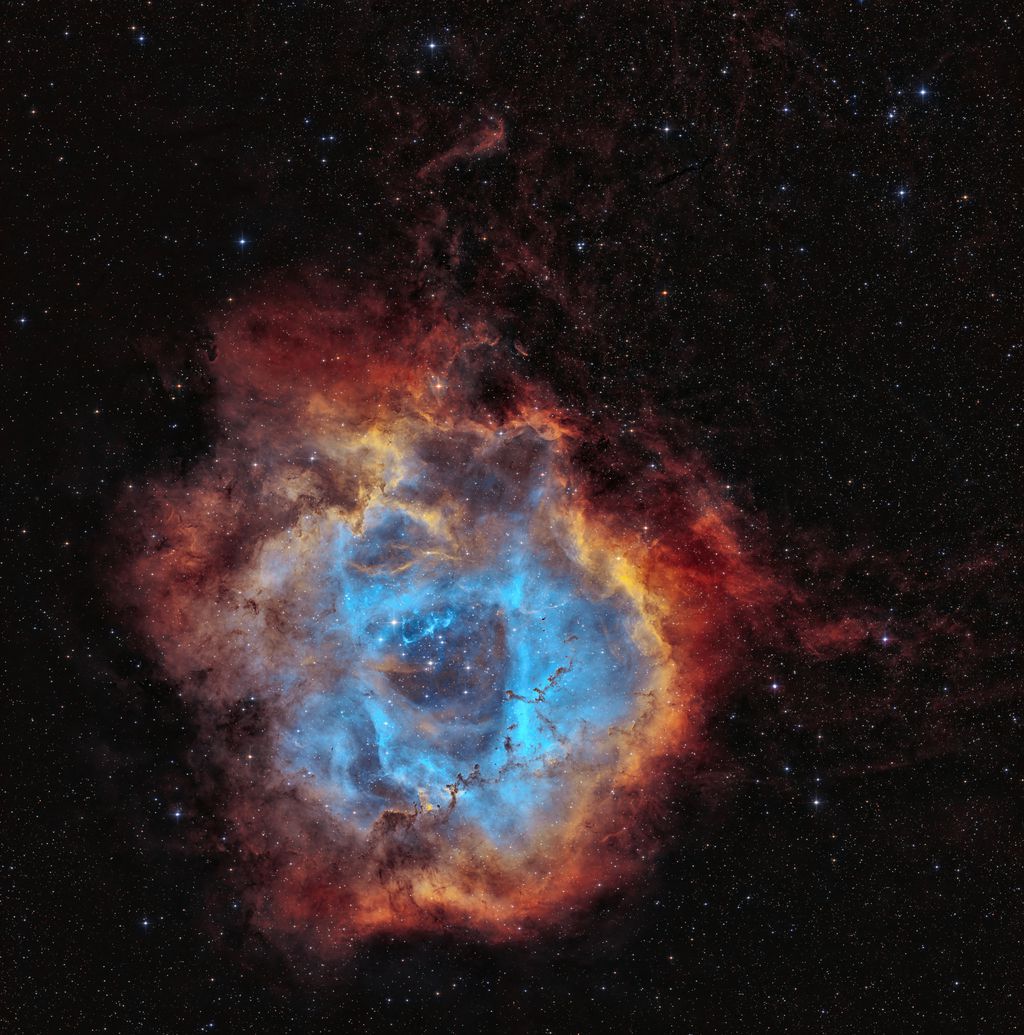Dear fellow astrophotographers,
Late in the season, I embarked on a project to create a 3x2 panel mosaic of the Rosette Nebula with the aim of producing a high-definition image of this magnificent object. Unfortunately, the weather did not cooperate as expected, resulting in only about 22 hours of data, equating to merely 3h40' per panel. This include 3h48' of RGB data for stars. Core equipment included a 200/800 Newtonian telescope and an ASI294mc pro camera coupled with a UV/IR cut filter for stars and an L-ultimate filter for DNB data.
You can view the picture here: https://www.astrobin.com/wabsb8/
In terms of processing the original version, I:
- Stacked each panel and, for DNB data, extracted Ha and OIII layers in SIRIL.
- In PixInsight, I assembled the RGB, Ha, and OIII layers.
- Key steps for processing the Ha and OIII data involved starnet2, gradient extraction, blurX, and linear fit.
- I assembled these layers using Pixemath with R=Ha, G= 0.7Ha+0.3OIII, and O=OIII.
- Applied light histogram transformation followed by an arcsin stretch (to preserve color), GHS, and NoisX. Subsequent steps included common cosmetic adjustments (masking, curves, local histogram, etc.). Stars were generated from the RGB stack, employing Gradient extraction, SPCC, blurX, starnet2, arcsin stretch, color saturation, curves, and unsharp masking.
I am looking for to suggestions for further for the version labeled "original".
Secondly, upon further consideration, I uploaded a version of the DNB data that I stacked and stitched to verify if my imaging plan was yielding stitchable panels. In this version, DNB data were stacked using the OSC script (without layer extraction) and the panels were quickly assembled. However, it consists of only 98 frames of 300 seconds each and lacks RGB stars. While this version is more rudimentary, I find myself drawn to its classical look alongside the first version.
Here's my second query: How do you perceive the colors of this second version (labeled "B") compared to the classical one? I may decide to develop a full version of it in the future.Thank you for your insights 
Clear skies,
Patrice
|
You cannot like this item. Reason: "ANONYMOUS".
You cannot remove your like from this item.
Editing a post is only allowed within 24 hours after creating it.
You cannot Like this post because the topic is closed.
|
You'd be better served, IMHO, by using HOO composition. That blue is way too electric for my taste. But then it is just my taste. Ignoring this gripe, I feel it is way overprocessed and oversmoothed, IOW it should look more natural than it does (to my eyes anyway).
|
You cannot like this item. Reason: "ANONYMOUS".
You cannot remove your like from this item.
Editing a post is only allowed within 24 hours after creating it.
You cannot Like this post because the topic is closed.
Thanks @andrea tasselli for your input. I guess I am still in my astro journey at a point where I like the flashy and electric colours. But I do agree that this might be too much already and will take that into account. I also see that you like particularly very soft processing. I do like you Rosettes.
Clear skies,
Patrice
PS : I know that I need to answer another thread where you provided inputs. I am not done with gathering light in order to reprocess and continue the discussion. But it will come.
|
You cannot like this item. Reason: "ANONYMOUS".
You cannot remove your like from this item.
Editing a post is only allowed within 24 hours after creating it.
You cannot Like this post because the topic is closed.
Version B, is not appealing in any manner. The green stars and clearly destructive background extraction kill it for me.
Version A is at a glance, visually appealing. From afar you still see an overpowering background from the Ha layer. Ha needs to be curved better and drop that signal off so you have a clean background exposing more black. Also, the 'background' contains alot of red chrominance noise that can probably easily be fixed by toning down and curving the Ha better. These are the things that stand out easily from a distance.
When you start looking closer at the image, oversharpening becomes rather evident looking at the globules. Fringe sharpness is overdone. Probably from too much BlurX and or additional unsharp masking. What made that worse is you denoised the data to an extreme level, I'm not sure if you were trying to hide something, or just weren't careful with its use. Lastly the stars look like doo-doo. The small ones feel like white polka dots, and the large ones have a wierd noisy halo surrounding a super tight core that just doesn't feel realistic at all.
Try this, take your raw data and do a basic HOO combination with no processsing, DBE is fine. Compare that image to the image you created. Does the raw image look better than what you processed? I'd be willing to be the answer is yes. Sometimes less is more. Go easy on the sliders with the scientology suite. They are very powerful tools that can be overdone easily.
|
You cannot like this item. Reason: "ANONYMOUS".
You cannot remove your like from this item.
Editing a post is only allowed within 24 hours after creating it.
You cannot Like this post because the topic is closed.
Thank you very much @Brian Puhl. That is a lot of material for reflexion and further processing attempts.
For the background part, I tried to retain the signal of dark dim structure in the north and east directions of the image. These are parts of the object. However, I realize that I would need much more data to make that appear in a satisfactory manner. As said I started that project to late. Maybe adding 20 hours at the end of the year will allow me to let these light Ha structures appear in a better way.
See here a good example for these darker structures : https://www.astrobin.com/92nvf3/?q=ngc%202244&camera=
The overdone diagnosis is certainly true. One may get a bit overenthousiastic with the tools. I think the unsharpmaking was indeed too much. Agreed.
As for the stars, I must admit that I lack a good solution. What you refer to is a typical problem of half of my image. This is the problem of the part of my image where I process stars with an initial gentle arcsin stretch, as advised in another thread on this forum, where I tried to improve.... to get something better than the other part of my image, where using GHS yield quite fat stars with a halo anyway. So here I fear that I am a bit lost. If you have any resources on the star-processing part, I am happy to learn.
Thanks again. I will reprocess that along softer lines.
|
You cannot like this item. Reason: "ANONYMOUS".
You cannot remove your like from this item.
Editing a post is only allowed within 24 hours after creating it.
You cannot Like this post because the topic is closed.
@Brian Puhl Here is a crop of a pure HOO autostretched part of the image. The denoise abuse comes certainly from the fighting with that noise.
 |
You cannot like this item. Reason: "ANONYMOUS".
You cannot remove your like from this item.
Editing a post is only allowed within 24 hours after creating it.
You cannot Like this post because the topic is closed.
Thank you very much @Brian Puhl. That is a lot of material for reflexion and further processing attempts.
For the background part, I tried to retain the signal of dark dim structure in the north and east directions of the image. These are parts of the object. However, I realize that I would need much more data to make that appear in a satisfactory manner. As said I started that project to late. Maybe adding 20 hours at the end of the year will allow me to let these light Ha structures appear in a better way.
See here a good example for these darker structures : https://www.astrobin.com/92nvf3/?q=ngc%202244&camera=
I think you should have plenty of signal for all the Ha structures in this image. 18 hours is alot for Rosette, which honestly is one of the brightest targets in the sky. It will just come down to massaging the curves a little better. I would take your Ha and Oiii channels and process them seperately, stretching them and curving the background appropriately. If I'm reading it right above, you processed them them in the linear stage, combined, THEN stretched. I'm not saying it's wrong to do things this way, but I prefer a stretched combination. For ensuring the background is curved appropriately, I suggest using the super-nuke button (boosted stretch), and if the background lights up like a flat panel, you'll know you need to tone it down more.
*Boosted stretch revealing the background issues* Note the histogram misalignment

As for the stars, I like to keep it simple, especially for your sake of learning. When you extract stars, Starnet and Starx both keep the same STF applied that you had in your linear image to the extracted layer. All you have to do is drag that STF from the stars over to the Histrogram and apply. Your stars will retain the natural stretch they had. If you want your stars more relaxed, you can loosen the STF sliders a bit before extraction. Once you've stretched your stars, you can add saturation with curves. Once happy, you can re-add them to your NB image with Charlie Hagen's guide that i'll link here.
https://www.nightphotons.com/guides/star-addition
If your final image has a red background again, you can fix it pretty easily by aligning the channels in the histogram.
*Background is a more neutral black, and histo is aligned*

In closing, there are many ways to skin the cat when we talk about narrowband combination. Probably very few people process like me. Most guides you will find online will have you go down much different paths. In the end, the results should all be the same. When I first started, I was very much like you, wanting to preserve all that background signal, leaving red backgrounds. In time, you will figure things out.
|
You cannot like this item. Reason: "ANONYMOUS".
You cannot remove your like from this item.
Editing a post is only allowed within 24 hours after creating it.
You cannot Like this post because the topic is closed.
@Brian Puhl Thanks a lot this are very valuable teachings. I do appreciate a lot.
I uploaded a new version trying;
- to balance the background as you proposed --> I go that
- to reduced the BG to an acceptable level using the "nuke mode" --> here I am still lacking a critera to decide whether it is acceptable or if this if the BG still qualifies as "flat panel lightening up";
- to process stars as you advised, applying in addition Bill Blanshan’s method for star reduction; that is much better than my recent arcsin obsession.
@andrea tasselli Thanks too. I tried to get a less agressive still in general. However, I must confess that I like the quite flashy colours.
I think I do like very much this version at this point. I thank you both very much. Of course, any further thoughts are most welcome. The journey does not stop here. This regarding, I hope to had data during the next nebula season. 18 hours is not bad, but this is 18 hours for six panels, i.e. 3 hours per panel.
Clear skies,
Patrice
Here is massively downsized version. The full version is accessible here : https://www.astrobin.com/wabsb8/C/
 |
You cannot like this item. Reason: "ANONYMOUS".
You cannot remove your like from this item.
Editing a post is only allowed within 24 hours after creating it.
You cannot Like this post because the topic is closed.
to create to post a reply.







